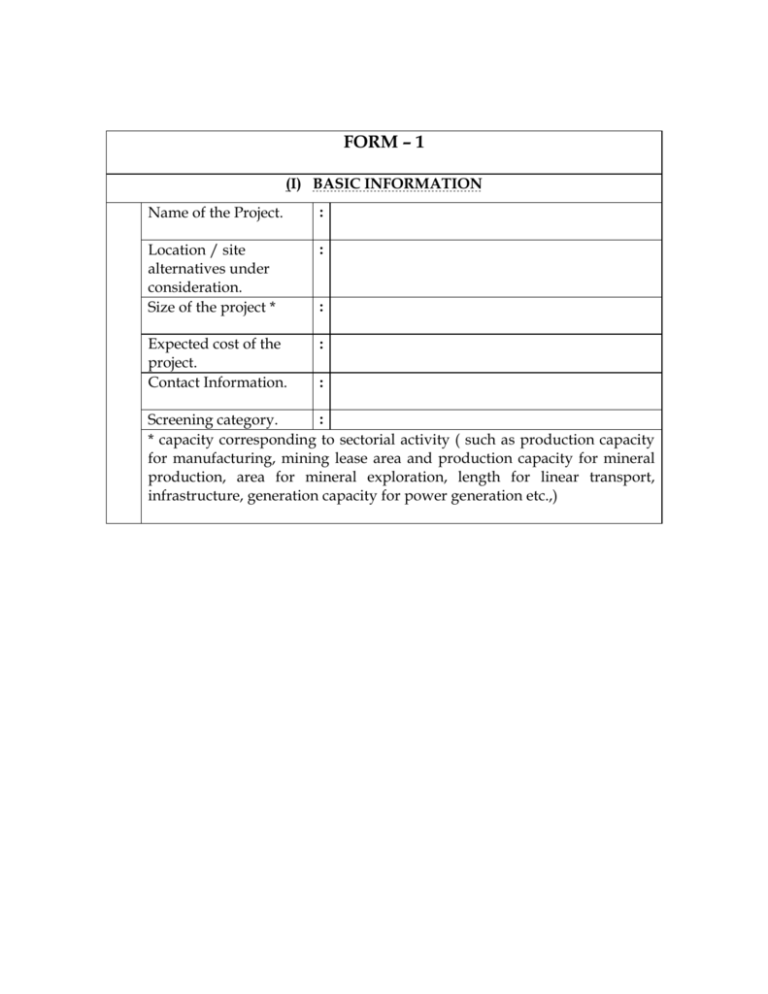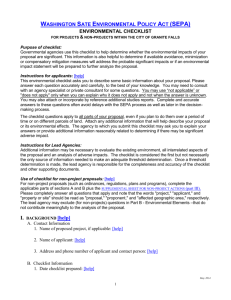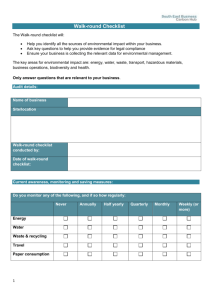EC Form I
advertisement

FORM – 1 (I) BASIC INFORMATION Name of the Project. : Location / site alternatives under consideration. Size of the project * : Expected cost of the project. Contact Information. : : : : Screening category. * capacity corresponding to sectorial activity ( such as production capacity for manufacturing, mining lease area and production capacity for mineral production, area for mineral exploration, length for linear transport, infrastructure, generation capacity for power generation etc.,) (II) ACTIVITY 1. Sr. No. 1.1 1.2 1.3 1.4 1.5 1.6 1.7 1.8 1.9 1.10 1.11 1.12 1.13 1.14 1.15 1.16 Construction, operation or decommissioning of the Project involving actions, which will cause physical changes in the locality (topography, land use, changes in water bodies, etc) Information / checklist Yes / Details thereof (with conformation. No. approximate quantities/ rates, wherever possible) with source of information data. Permanent or temporary change in land use, land cover or topography including increase in intensity of land use (with respect to local land use plan.) Clearance of existing land, vegetation and buildings? Creation of new land uses. Pre-construction investigations e.g. bore house, soil testing? Construction works? Demolition works? Temporary sites used for construction works or housing of construction workers? Above ground buildings, structures or earthworks including linear structures, cut and fill or excavations. Underground works including mining or tunneling? Reclamation works? Dredging? Offshore structures? Production and manufacturing processes? Facilities for storage of goods or materials? Facilities for treatment or disposal of solid waste or liquid effluents? Facilities for long term housing of operational workers? 1.17 New road, rail or sea traffic during construction or operation? 1.18 New road, rail, air waterborne or other transport infrastructure including new or altered routes and stations, ports, airports etc? 1.19 Closure or diversion of existing transport routes or infrastructure leading to changes in traffic movements? 1.20 New or diverted transmission lines or pipelines? 1.21 Impoundment, damming, culverting, realignment or other changes to the hydrology of watercourses or aquifers? 1.22 Stream crossing? 1.23 Abstraction or transfers of water form ground or surface waters? 1.24 Changes in water bodies or the land surface affecting drainage or run-off? 1.25 Transport of personnel or materials for construction, operation or decommissioning? 1.26 Long-term dismantling or decommissioning or restoration works? 1.27 Ongoing activity during decommissioning which could have an impact on the environment? 1.28 Influx of people to an area in either temporarily or permanently? 1.29 Introduction of alien species? 1.30 Loss of native species or genetic diversity? 1.31 Any other actions? 2 Use of Natural resources for construction or operation of the Project (such as land, water, materials or energy, especially any resources which are non-renewable or in short supply): Sr. Information / Checklist Yes / Details thereof (with No. conformation. No. approximate quantities / rates, wherever possible) with source of information data. 2.1 Land especially undeveloped or agricultural land (ha) 2.2 Water (expected source & competing users) unit: KLD 2.3 Minerals (MT) 2.4 Construction material – stone, aggregates, sand / soil (expected source – MT) 2.5 Forests and timber (source MT) 2.6 Energy including electricity and fuels (source, competing users) Unit: fuel (MT),energy (MW) 2.7 Any other natural resources (use appropriate standard units) 3 Use, storage, transport, handling or production of substances or materials, which could be harmful to human health or the environment or raise concerns about actual or perceived risks to human health. Sr. Information / Checklist Yes / Details thereof (with No. conformation. No. approximate quantities / rates, wherever possible) with source of information data. 3.1 Use of substances or materials, which are hazardous (as per MSIHC rules) to human health or the environment (flora, fauna, and water supplies) 3.2 Changes in occurrence of disease or affect disease vectors (e.g. insect or water borne diseases) 3.3 Affect the welfare of people e.g. by changing living conditions? 3.4 Vulnerable groups of people who could be affected by the project e.g. hospital patients, children, the elderly etc., 3.5 Any other causes. 4. Production of solid wastes during construction or operation or decommissioning (MT/month). Sr. Information / Checklist Yes / Details thereof (with No. conformation. No. approximate quantities / rates, wherever possible) with source of information data. 4.1 Spoil, overburden or mine waste. 4.2 Municipal waste (domestic and or commercial wastes) 4.3 Hazardous wastes (as per Hazardous Waste Management Rules) 4.4 Other industrial process wastes 4.5 Surplus product 4.6 Sewage sludge or other sludge from effluent treatment. 4.7 Construction or demolition wastes 4.8 Redundant machinery or equipment. 4.9 Contaminated soils or other materials. 4.10 Agricultural waste. 4.11 Other solid wastes. 5. Release of pollutants or any hazardous, toxic or noxious substances to air (Kg/hr) Sr. Information / Checklist Yes / Details thereof (with No. conformation. No. approximate quantities / rates, wherever possible) with source of information data. 5.1 Emissions from combustion of fossil fuels from stationary or mobile sources 5.2 Emissions from production processes. 5.3 Emissions from materials handling including storage or transport. 5.4 Emissions from construction activities including plant and equipment 5.5 Dust or odours from handling of materials including construction materials, sewage and waste. 5.6 Emissions from incineration of waste. 5.7 Emissions from burning of waste in open air (e.g. slash materials, construction debris) 5.8 Emission from any other sources. 6. Generation of Noise and Vibration, and Emissions of Light and Heat: Sr. Information / Checklist No. conformation. 6.1 6.2 6.3 6.4 6.5 6.6 6.7 Yes / No. Details thereof (with approximate quantities / rates, wherever possible) with source of information data. From operation of equipment e.g. engines, ventilation plant, crushers. From industrial or similar processes. From construction or demolition. From blasting or piling. From construction or operational traffic. From lighting or cooling systems. From any other sources. 7. Risks of contamination of land or water from releases of pollutants into the ground or into sewers, surface waters, groundwater, coastal waters or the sea: Sr. Information / Checklist Yes / Details thereof (with No. conformation. No. approximate quantities / rates, wherever possible) with source of information data. 7.1 From handling, storage, use or spillage of hazardous materials. 7.2 From discharge of sewage or other effluents to water or the land (expected mode and place of discharge) 7.3 By deposition of pollutants emitted to air into the land or into water 7.4 From any other sources. 7.5 Is there a risk of long term build up of pollutants in the environment from these sources? 8. Risk of accidents during construction or operation of the Project, which could affect human health or the environment. Sr. Information / Checklist Yes / Details thereof (with No. conformation. No. approximate quantities / rates, wherever possible) with source of information data. 8.1 From explosions, spillages, fires etc. from storage, handling, use or production of hazardous substances. 8.2 From any other causes 8.3 Could the project be affected by natural disasters causing environmental damage (e.g. floods, earthquakes, landslides, cloudburst etc)? 9. Factors which should be considered (such as consequential development) which could lead to environmental effects or the potential for cumulative impacts with other existing or planned activities in the locality. Sr. Information / Checklist Yes Details thereof (with No. conformation. / approximate quantities / rates, No. wherever possible) with source of information data. 9.1 Lead to development of supporting localities, ancillary development or development stimulated by the project which could have impact on the environment e.g.: • Supporting infrastructure (roads, power supply, waste or waste water treatment, etc.) • housing development • extractive industries • supply industries • other 9.2 9.3 9.4 Lead to after – use of the site, which could have an impact on the environment. Set a precedent for later developments. Have a cumulative effect due to proximity to other existing or planned projects with similar effects. (III) ENVIRONMENTAL SENSITIVITY. Sr. Area. Name / Aerial distance (within 15 No. Identity km.) Proposed project location boundary. 1 Areas protected under international conventions, national or local legislation for their ecological, landscape, cultural or other related value. 2 Areas which are important or sensitive for ecological reasons Wetlands, watercourses or other water bodies, coastal zone, biospheres, mountains, forests. 3 Areas used by protected, important or sensitive species of flora or fauna for breeding, nesting, foraging, resting, over wintering, migration. 4 Inland, coastal, marine or underground waters 5 State, National boundaries. 6 Routes or facilities used by the public for access to recreation or other tourist, pilgrim areas. 7 Defence installations. 8 Densely populated or built – up area. 9 Areas occupied by sensitive manmade land uses (hospitals, schools, places of worship, community facilities) 10 Areas containing important, high quality or scare resources (ground water, surface resources, forestry, agriculture, fisheries, tourism, minerals) 11 Areas already subjected to pollution or environmental damage. (those where existing legal environmental standards are exceeded) 12 Areas susceptible to natural hazard which could cause the project to present environmental problems (earthquakes, subsidence, landslides, erosion, flooding or extreme or adverse climatic conditions)








